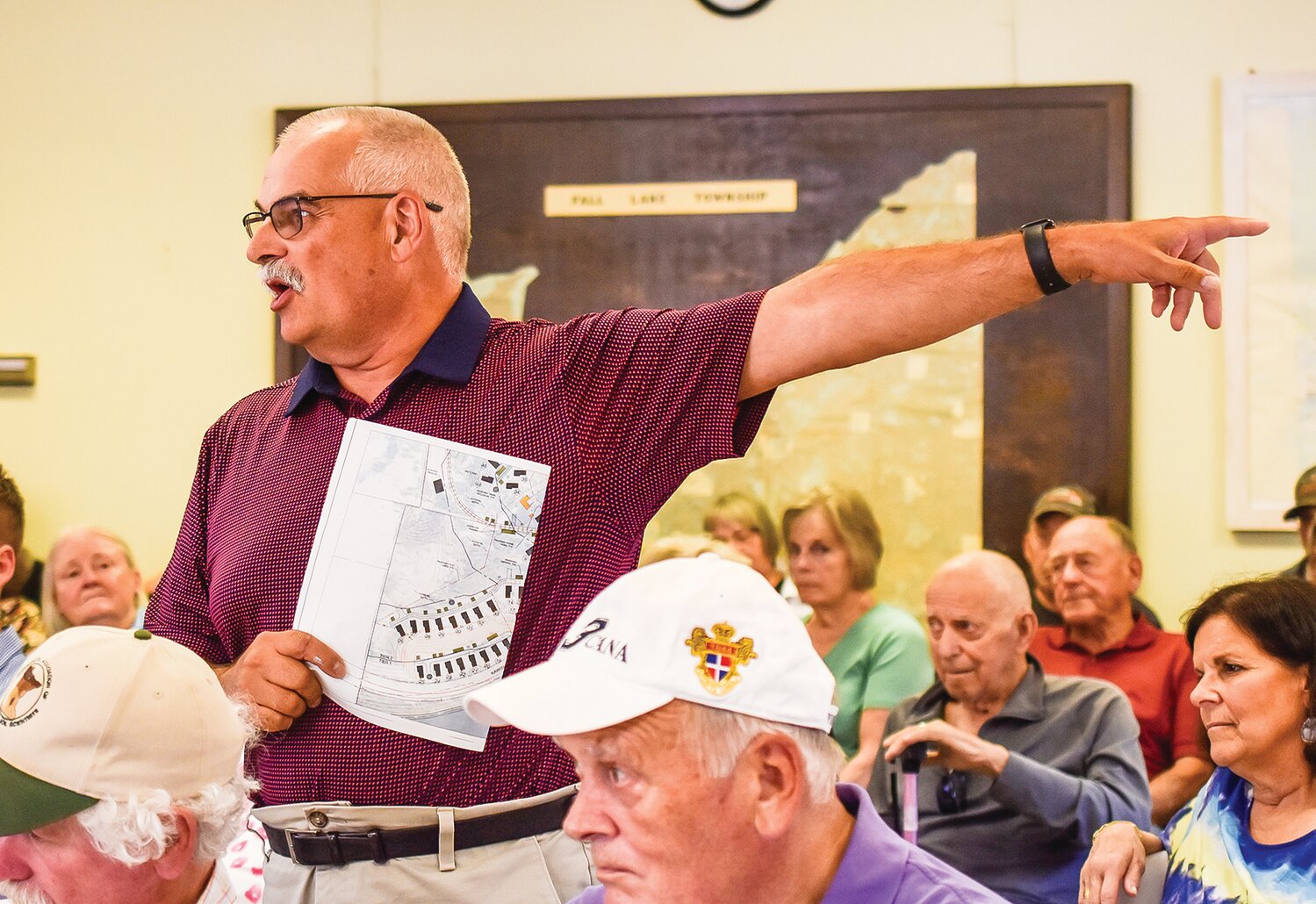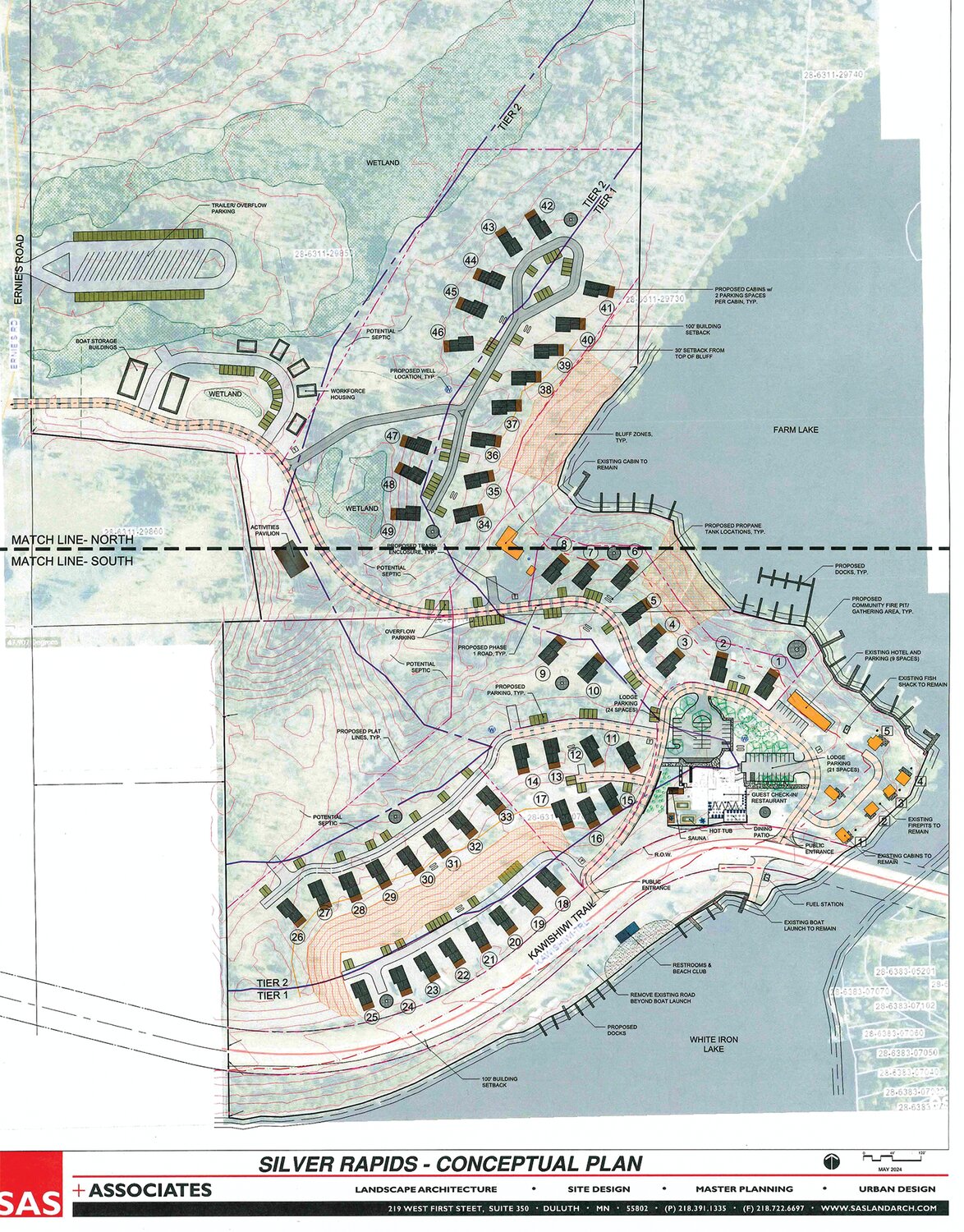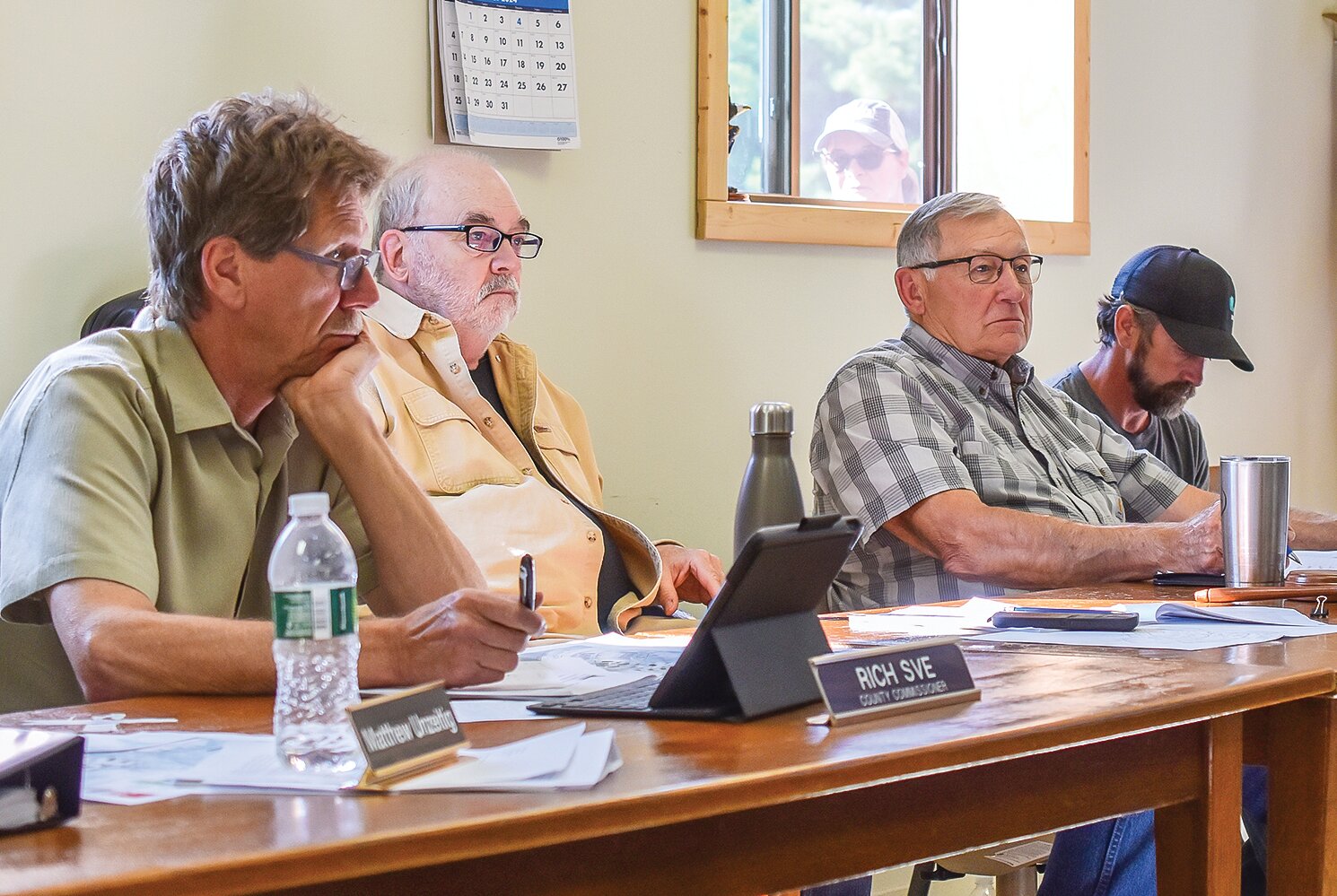Support the Timberjay by making a donation.
Many questions over Silver Rapids expansion
Lake County Planning Commission tables action on CUP and plat
FALL LAKE- It was standing room only during a public hearing here last week when the Lake County Planning Commission took testimony on the proposed expansion of the Silver Rapids Lodge. The …
This item is available in full to subscribers.
Attention subscribers
To continue reading, you will need to either log in to your subscriber account, below, or purchase a new subscription.
Please log in to continue |
Many questions over Silver Rapids expansion
Lake County Planning Commission tables action on CUP and plat
FALL LAKE- It was standing room only during a public hearing here last week when the Lake County Planning Commission took testimony on the proposed expansion of the Silver Rapids Lodge. The developers submitted two zoning applications for the proposed expansion of the resort property, located along the narrows between Farm and White Iron lakes.
The first seeks a conditional use permit required by the county’s land use ordinances for the expansion, which includes adding 68 boat slips to the 22 already on the property. The second application was for a preliminary plat to subdivide the property for 49 “one-quarter fractional share cabins.” These privately-owned cabins would be used in a variation of a time-share scheme where each cabin would be shared by four owners.
At the end of the hearing, which lasted three hours, the commission tabled action on the two applications pending more information from the developers. They also scheduled their next meeting on the subject for Aug. 8 at 4 p.m. to review any new material provided by the developers and to consider the applications. The meeting will be held at the Fall Lake Town Hall. Public testimony will not be taken at the Aug. 8 meeting.
A major change proposed
The year-round Silver Rapids Lodge currently includes a main lodge with a restaurant, an 11-unit motel, a boathouse, bathhouse, playground, boat ramp, 12 cabins, 15 full hook-up RV sites, four interior camping sites, 21 lakeside camping sites, and nine docks with 22 boat slips. The resort, spread across 62 acres, has one water well and one septic system.
The developers propose to update the resort facilities as well as subdivide much of the resort’s unused property to build and sell the 49 fractional cabins, each with a footprint of 1,488-square-feet, including a balcony. These would be built on the bluffs overlooking the two lakes, with the balconies oriented to provide lake views.
The current proposal would develop the property in three phases. According to the plat application, phase one includes construction of 15 new fractional cabins, new lakeside restrooms, and a Tiki bar. It also would include tearing down and replacing the lodge building, remodeling the motel and six of the existing rental cabins, and removing all RVs and stationary trailers and razing the rest of the existing cabins and the bathhouse.
Phase two includes 18 new fractional cabins and an activities building. Phase three would see 16 new fractional cabins built, along with five units of workforce housing, two boat storage buildings and an overflow trailer parking lot.
Based on the application paperwork, the development will add 68 new boat slips on 30 docks. The two applications did not detail how many docks or slips would be added during each phase.
Each one-quarter fractional share cabin would receive one slip. The remodeled rental cabins would have five slips and the motel would have six. The remaining 30 slips would be allocated to the restaurant and transient boat traffic. During the hearing, Sandy Hoff, speaking for the developers, said that 12 of the 30 remaining slips would be for boat rentals.
On the conceptual plan prepared for the developers by SAS Associates of Duluth, nineteen docks are on the resort’s Farm Lake shoreline. The eastern side of Farm Lake is part of the Boundary Waters Canoe Area Wilderness, two miles from the resort.
The developers
The expansion of Silver Rapids is a project of the Silver Rapids Lodge SPE LLC, which is a joint venture of the current resort owners and Storie Co. Indianapolis-based Storie Co. bills itself as “a hotel investment, asset management, and development firm specializing in hotel and resort properties in select secondary and tertiary drive-to markets that possess unique appeal and demand drivers.”
The preliminary plat application states that the current resort management company running Silver Rapids, Leisure Hotels & Resorts, will be retained to manage the expanded and revamped resort.
The hearing
More than 90 people attended last week’s hearing, which overwhelmed the town hall’s 60-person occupancy limit, prompting commissioners to ask some of the attendees to leave the building. Many of those who did leave stood outside and listened to the three-hour hearing through open windows. Two of the people who testified came in from outside to do so.
The commissioners heard from nineteen members of the public from Fall Lake and surrounding communities, none of whom were in favor of the resort expansion in its current form.
Mary Zimmerman has just one property between her home and the resort. She expressed concerns over the large scale of the project that many others at the hearing shared. Zimmerman listed the virtues of the quiet lakes and woods, contrasting that with the noise, congestion, and negative environmental impacts an expanded resort might produce.
“I will never hear another loon once this project has been completed, and I think that that should be a concern,” she said. “We can’t just look at the money involved … Once you start this project, (the area) will never return to what it was before. We’ve lost it forever. I’m not opposed to renovating Silver Rapids. People in my family have stayed there. But this is way too much.”
Other comments echoed those themes. Three of those who testified stated their fear that the introduction of large corporate-run resorts in the area will turn the local lakes into something resembling Lake Minnetonka with properties most people can’t afford.
Tony Porthan, who owns a cabin on White Iron Lake, spoke about concerns that the resort expansion will raise tax assessments. “You have million dollar (time share cabins) at $250,000 for a quarter share. I want to know what that’s going to do all of us in this room. I don’t think it’s going to be pretty because we’re going to be taxed out of our places … We’re excited to see something happen with Silver Rapids but the scale of what is happening will tax most people out of this room.”
Residents also worried the scale of the development would bring in people who don’t live here and won’t treasure the area’s unique assets and lifestyle.
Amy Stewart, who lives on the other side of the bridge from the resort, said she fears excessive boat traffic and speed. “These people have no investment in this community,” she said. “So, they are not going to be slowing down when the rest of our boats and docks are at risk, and our shoreline is at risk.” Stewart also mentioned the resort contributing to light pollution in one of the few dark sky sanctuaries in the U.S., increasing the noise pollution on the lakes, increasing the amount of trash, introducing pesticides, and degrading water quality, all because of the size of the proposed expansion.
In addition to the 19 people who spoke to the planning commission, 25 people sent written communications about the resort expansion. Lake County Environmental Services Director Christine McCarthy summarized the highlights of the written testimony, “The majority of the concerns were density (of the development), aquatic invasive species, boat traffic and jet skis … and traffic on Kawishiwi (Trail).”
When the hearing was done, planning commissioner Mike Hoops remarked “I never expected this amount of testimony.”
The staff report
Every land use application is reviewed by the county’s technical staff for its compliance with the requirements of the county’s ordinances and state law, and those reports often include recommendations and findings. In their written report to the board, the county staff noted that the applications appeared to require the completion of a state Environmental Assessment Worksheet, or EAW, and that water supply issues seemed to be unresolved. The report also recommends that the county request more information on pedestrian safety and road traffic.
The need for an EAW was based on the number of new units proposed. As the county’s assistant environmental services director Tanya Feldkamp explained during the hearing, an EAW is mandatory for a resort expansion if the number of new units along non-sensitive lakes is more than 50. She noted that the choice to build 49 units may have been due to this EAW limit. Feldkamp added, however, that the proposed workforce housing “kind of plumps up the total number of units to over 50.”
McCarthy highlighted problems regarding water supply, casting doubt on the ability of the resort to rely on well water.
“We want to be very careful,” McCarthy said, “that any wells are not going to draw down anybody else’s. We also have the lake. Is there going to be some lake water supply? And if it exceeds a million gallons per year, the water appropriation needs to be considered.”
The staff report noted that water use over one million gallons per year requires a water appropriations permit from the Department of Natural Resources. The permitting process may require an aquifer study.
Sewage treatment was also an area of concern. In the second phase of development, sewage flows would exceed 10,000 gallons per day, a level of flow that requires a state permit.
The report went on to note several different ways that traffic and pedestrian information could be improved, including conducting a trip generation analysis and a traffic study to determine if a turn lane was necessary.
The rebuttal
Luke Sydow, a landscape architect from SAS Associates of Duluth, spoke on behalf of the developers after the close of the public testimony. Though others spoke after him, Sydow covered most of the points made by the development team to present the project as a benefit to the community.
Sydow said that when all the current RV sites, trailer homes, cabins, and motel rooms on the property are counted up, the number of lodging units isn’t very different from the number of proposed units of the expanded resort.
“If you do the math on that, we’re close to 57 units,” said Sydow. “The density that we’re proposing is very similar for what’s there. We’re not proposing a huge density increase, what we’re doing is cleaning up.” With the 49 shared cabins, the rental cabins, and the remodeled motel, the total number of units in the expanded resort will be 61.
Sydow argued that the expansion will clean up the waterfront by removing the RV sites, trailers, and camping sites. “We’re also proposing to move a good majority of the cabins on Farm Lake to be inside of the (300-foot) setback. We’re also proposing to restore the existing gravel mining operation, to revegetate that and use a portion of that in phase one home sites.”
Sydow said the expansion also includes the restoration of shoreline vegetation at the RV sites on White Iron Lake. The developers will also use dark sky friendly lighting. “I would never propose anything that’s not dark sky compliant,” he said.
Sydow also said that the expansion is “not something that’s going to happen overnight.” The phased approach would evolve the site gradually. He mentioned adding the docks would also evolve. “There’s no intent to put all the docks in on day one. The intent is to build the docks as we need them.”
Sydow also addressed some of the storm water runoff concerns, pointing out that creating the 300-foot vegetative buffer would provide stormwater improvements.
He also touched on traffic concerns, stating the renovation of the property included a one-way traffic circle off of the Kawishiwi Trail around the lodge and removing the camping sites to improve traffic flow. He was open to the idea of a pedestrian underpass on the bridge.
Others spoke on behalf of the developers, including Alex Bushey who described himself as “a member of the development team.” Bushey is part of the Duluth office of F. I. Salter Real Estate. “We’re limiting our access to Kawisiwi Trail to limit traffic flow. There are improvements we take seriously in communities like this where we’ve been before. This isn’t a fly by night operation. We’ve done the studies.”
The planning commission also grilled Bob Whitmyer, the developers’ wastewater engineer on the new septic system currently being installed on the site and the plans to expand the sewage treatment systems in the future to meet the projected increase in wastewater flows.
Commission response
The planning commission members peppered the developers for close to two hours on their plans, asking questions on boat traffic, slip density, fuel storage, the boat launch, and traffic control. The commissioners also noted the lack of storm water, water supply, and traffic control information in the applications.
“We usually have a lot more information when we get to this point. The issues are not with the conditional use permit. It’s the plat.”
The commissioners voted to table consideration of the two applications until the Aug. 8 meeting. In the interim, they directed the developers to provide more information on their plans on multiple items, including for storm water, water supply, boat slips and docks, boat traffic, pedestrian traffic, and road traffic.











